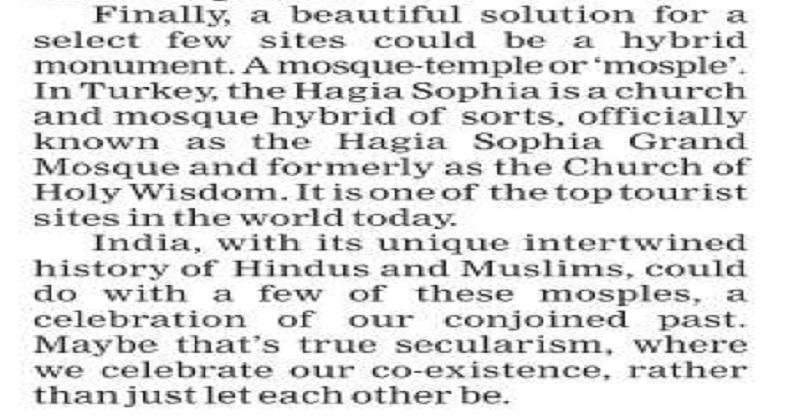
The acclaimed novelist and pundit Chetan Bhagat has recently been in the headlines. His name is often in the headlines, whether it’s for his incredible readings or his writings. Chetan Bhagat recently argued in a TOI piece that ‘Mosques + Temples = Mosples.’ He said that by employing this reasoning, many religious radicals might avoid future clashes by recognizing their common past.
To illustrate this argument, Chetan Bhagat uses Istanbul’s Hagia Sophia, which he describes as a ‘church and mosque hybrid of sorts’. This is an absolutely false allegation because the historical place was not a mosque-and-church combination called ‘morch. However, as Chetan Bhagat points out, it has operated as both a church and a mosque at different points in time. Many internet users thought Chetan Bhagat’s ‘mosple’ concept was ludicrous. Chetan + Shut up = Chup, Vomit + Puke = Voke, Britain + India = Bridia, and so on.
See the post here:
Hi all,
“Mosques + Temples = Mosples: Controversies like Gyanvapi can be avoided if Hindus and Muslims together celebrate their conjoined past,” my column in TOI.
Do read and share! pic.twitter.com/jWYfjWXfQ1
— Chetan Bhagat (@chetan_bhagat) June 4, 2022
While there are several examples of temples and mosques, or other religious houses of worship, placed on nearby properties, the proposal of a single hybrid site of worship for multiple places is certainly odd, unexpected, and weird. Interestingly, Bhagat offered two further ideas in the same piece that were not mentioned by the Times of India or the author himself. Actually, the ‘mosples’ concept was the third of three, and the other two are both rational and realistic.
For much of its existence, Hagia Sophia was a church, but it is now a mosque. It was established in the sixth century in Istanbul, Turkey, on the site of an earlier church destroyed by fire. This church was built after the previous church was also destroyed by fire. The current edifice was finished in 537 as the Church of Justinian I, after Emperor Justinian I, who initiated its construction, and remained a church for hundreds of years, until Ottoman troops seized the city.

In the first, he has proposed that the Places of Worship Act be amended to allow temples that were converted to mosques to be reverted back. He proposed identifying those places that are tremendously important to Hindus but have no special value to Muslims and converting them into temples. It is a decent starting point for resolving the disagreements even if it covers 99.99% of the sites but excludes just 0.01 percent.
Conjoined past, Mospels ??
Looters and Invaders are getting mainstreamed through such words by morons like Bhagat. There is term for Hindus like him "Dhimmis" https://t.co/79NB95IO6E
— Chandan ?? (@CKSahay_) June 4, 2022
Chetan Bhagat’s second recommendation is that one community acquire the sites from the other group that is now occupying the properties. This is also a useful suggestion. While Waqf law prohibits the sale of Islamic sites, a way around it can be found if both sites agree, as was done in the case of the Kashi Vishwanath Corridor, when a plot needed for the project was taken from the Gyanvapi mosque and another plot was given in exchange, circumventing the Waqf property law.
Hindus can certainly provide alternate locations for Muslims to move mosques erected on the remains of old temples. While extremist Muslims would not agree with any of these recommendations, they are unquestionably better and more realistic alternatives than ‘Mosples.’ While it is clear why the Times of India picked the most contentious choice for the title, it is unclear why Chetan Bhagat chose it as well. This is because he shared the item on Twitter. He probably believes it’s the greatest idea.

Post Your Comments